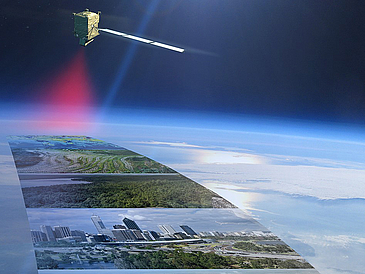The CarbonSat satellite concept developed by the Institute for Environmental Physics is based on the taking of high-resolution pictures of the greenhouse gases CO2 and methane. Using the pictures it will be possible, amongst other things, to make the waste gas plumes of localized, strong CO2 emitters, such as power plants, industrial facilities, and towns, visible and thus determine their emissions.
At the ESA Ministerial Council meeting in Seville, it was decided to release the funds for the greenhouse gas satellite CO2M in the frame of the European COPERNICUS program. It is planned that there be a constellation of CO2M satellites that will be launched in 2025. “The decision made by the ESA Ministerial Council to provide funds validates us as researchers at the IUP,” says Heinrich Bovensmann happily. He was the scientific lead of CarbonSat from 2010 to 2015. “We will continue to research innovative remote sensing methods that are not only scientifically but also environmentally of great significance.” The ESA member states have provided 1.8 million euros for six Copernicus missions, including CO2M.
Worldwide Interest in Better Measurement Results
After the construction of the CO2M system, Europe will have a unique and independent information source that is scientifically and politically relevant. The Institute for Environmental Physics scientists are still involved in the construction of the system, for example with the development of innovative data analysis methods and aircraft-based greenhouse gas measurements. “There is a great interest worldwide in the corresponding information. Up until now, I was only able to answer such requests with the reply that current satellites can only provide restricted information on CO2 emission sources. That will change in the future,” says Dr. Michael Buchwitz from IUP. As a member of an international expert team, he provides advice to the European Space Agency ESA and the European Commission in the frame of realizing the concept.
The CO2M concept is based on the findings made by the satellite sensor SCIAMACHY, which was also developed in Bremen under the scientific lead of Professor John P. Burrows. The CarbonSat measuring concept, which was advanced by Bovensmann and his colleagues, received funding 10 years ago from Bremeninvest (WFB), the University of Bremen and DLR Space Administration.
Further Information:
https://ec.europa.eu/jrc/en/science-update/measuring-man-made-carbon-dioxide-co-emissions-support-paris-agreement
www.iup.uni-bremen.de/carbonsat/ http://www.iup.uni-bremen.de/optronics/projects/methaneairbornemappermamap/index.htm
www.iup.uni-bremen.de/carbon_ghg (University of Bremen)
www.esa.int/Applications/Observing_the_Earth/Copernicus/Copernicus_High_Priority_Candidates
www.uni-bremen.de/en/
Contact:
Dr. Heinrich Bovensmann
University of Bremen
Institute for Environmental Physics
Phone: +49 (0)421 218 62102
Email: heinrich.bovensmannprotect me ?!uni-bremenprotect me ?!.de
Dr. Michael Buchwitz
University of Bremen
Institute for Environmental Physics
Phone: +49 (0)421 218-62086
Email: buchwitzprotect me ?!uni-bremenprotect me ?!.de

